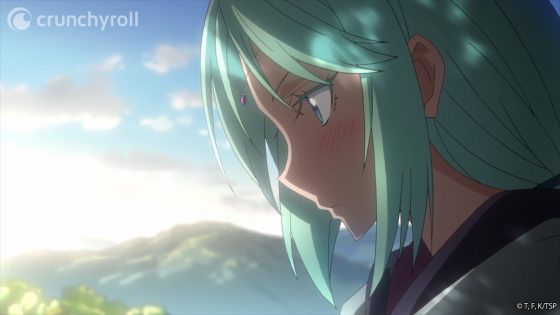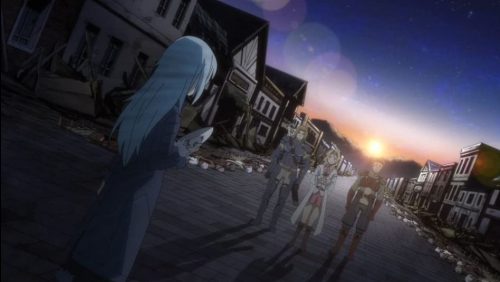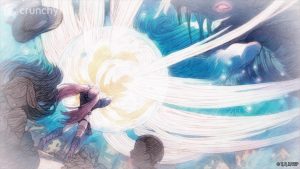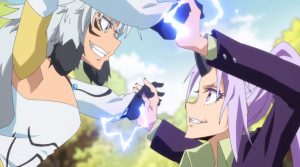Tensei Shitara Slime Datta Ken (That Time I Got Reincarnated As a Slime) season 2 is heating up a lot more than anticipated! Rimuru and his city-state of Tempest have their hands full dealing with their first-ever participation in the tragedy that is war. With the human Kingdom of Falmuth using technicalities to justify their brutality against the monsters in Tempest, Rimuru gains first-hand experience of the bloody senselessness of war.
For the first time since the beginning of the series, Rimuru is viscerally shaken by what he sees but quickly collects his emotions in order to figure out what happened, and what to do next. What went wrong for the city of Tempest? Could this perhaps be the introduction a permanent, darker feel to the series? Here’s what we think!
– Spoilers Ahead –
The Lore of Naivety
One of the most important themes in That Time I Got Reincarnated As a Slime is fantasy. After being reincarnated in another world, Rimuru got a basic understanding of how the world works, as well as a general understanding of the universe as something akin to role-playing videogames. However, he has only just begun gathering information about the less-metaphysical, more-practical aspects of the world, such as politics.
Rimuru came to understand a little bit about the lore but did not realise what his influence would do to that lore. As a result, he established a peaceful nation of monsters free from discrimination but with growing success comes an ever-growing list of unintended enemies. The Kingdom of Falmuth playing dirty to be justified (according to their church at least) in their waging of war is partly to do with Tempest’s emergence as a trade centre. Falmuth has been considered the trade centre of the western powers for a very long time and Tempest’s presence results in the loss of profit.
Ultimately, Tempest was attacked by Falmuth because of its success, because of hatred, and also because Rimuru ignored the realities of the world in favour of a prettier, more idealistic understanding. Due to this paradigm, Rimuru established Tempest on three conditions, one of which being non-violence towards humans. This order is partly what prevented the forces of Tempest from truly retaliating against human enemies.
The Three Laws of Tempest Monsters
Rimuru feels guilty about the events that transpired in Tempest because he was held up fighting against Sakaguchi Hinata, but also because one of the three laws Rimuru declared when establishing Tempest ended up being a severe handicap for the monsters defending themselves. Tempest was established on three conditions: 1) that there is no infighting among monsters; 2) that there is no discrimination among monsters who live in the Jura Tempest Federation and finally, the fatal law; 3) that citizens of Tempest are not to harm humans. The monsters who died in the Falmuth ambush maintained these three promises, especially the last one and it cost them their lives. Rimuru’s emotions are in utter disarray as it dawns on him that his words are ultimately what caused the sheer number of fatalities.
The Mole

Myulan’s presence in Tempest is partly to blame for the destruction that ensued on the day Falmuth attacked. Her erection of an anti-magic barrier made even some of Tempest’s finest warriors inept in the face of human enemies. Myulan’s allegiance to the Demon Lord Clayman is part politics, part Demon Lord agenda, as Clayman uses the growing unrest in Falmuth to carry out a personal vendetta against Rimuru Tempest.
Loss and Guilt
By the end of the 7th episode of the second season of That Time I Got Reincarnated As A Slime, we see the extent of the damage caused by the forces of Falmuth. Among the casualties are the quiet but likeable Gobzo and an unexpected death: Shion, Rimuru’s Kijin secretary. Overcome with grief and finding himself unable to really express it, Rimuru feels the last remnants of his humanity slipping away.
However, when he hears about a fairy tale concerning a dragon princess who managed to revive her dragon companion from the dead, the embers of hope become a small flame. The catch is that Rimuru would have to become a Demon Lord and still have access to the souls of the dead to be able to accomplish such a feat. Lucky for him; however, the double barrier erected by the enemy has a small chance of acting as a net for the souls of the departed, meaning that unlike in the fairy tale, a complete revival of the dead could be possible.
Never having experienced loss due to war and politics, Rimuru decides to embrace his monstrosity. He requires ten thousand human souls to kickstart his evolution to True Demon Lord status, and with the Kingdom of Falmuth’s forces approaching twenty thousand strong, Rimuru’s goal to revive his friends seems to be putting itself together quite nicely.
Final Thoughts

Many things went wrong for Tempest in the recent episodes of That Time I Got Reincarnated As a Slime season 2; however, the series itself is improving immensely and giving us a darker, more serious tone, especially in episodes 6 through 8! We might just get a full-on war between Rimuru and the forces of Falmuth, but this season also boasts a beautifully unfolding lore that definitely needed all of last season to set up. What are your thoughts on the emerging war between humans and monsters in That Time I Got Reincarnated As a Slime season 2? Drop a comment below and tell us what you think!
Recommended Post







